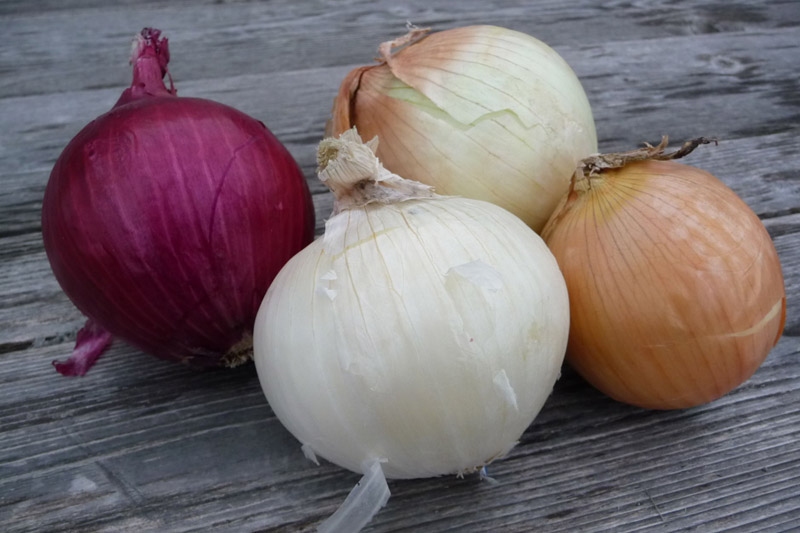How Do I Get My Onions to Grow Bigger? Onions are frequently touted as one of the simplest crops to cultivate. They don’t have many severe insect problems and may be grown anywhere in the garden that has well-drained soil and full sun exposure. Despite these benefits, gardeners are frequently disappointed when their onions do not grow huge bulbs at the end of the season. If your onions didn’t grow as big as you’d want this season, keep the following recommendations in mind for next year:
How Do I Get My Onions to Grow Bigger?

1. Choose the Variety
Onion cultivars are classified into three types: long-day, short-day, and intermediate-day onions. Onion plants rely on the length of the day to decide when they will begin to create bulbs. When long-day onions receive at least 14 hours of sunlight every day, they begin to develop bulbs. These kinds are ideal for New Hampshire gardens since the summer days are long and the onions have plenty of time to produce numerous leaves before bulb production begins.
Short-day onions are ideal for the deep south since they require only 10-12 hours of light to begin bulb production. Although short-day onions can be grown in the Granite State, they will most likely only yield little bulbs because they will begin bulb growth when they are still small and only have a few leaves. When the day length approaches 12-14 hours, intermediate-day kinds begin to sprout bulbs. In northern gardens, these are similarly unlikely to develop into full-size bulbs.
Make sure you’re growing bulbing onions rather than bunching onions. Bunching onions will become scallions and never produce huge bulbs. Shallots will also remain significantly smaller than yellow, red, or sweet onions.
2. Plant at Time
When onions are planted too late, they frequently produce disappointingly little bulbs. If you plan to raise onions from seed, start them indoors in late winter/early spring to give them a head start. Between mid-February and mid-March, start onion seeds 10-15 weeks before you expect to be able to transplant them into the garden. Onions are frost resistant and can be planted in the garden in late April or May. It is also feasible to straight sow seeds in the garden as soon as the soil is workable in the spring, but the producing onions will be smaller.
Onion sets can be planted as soon as the soil is workable. Sets are young bulbs that have been kept for the winter. Sets allow for an earlier harvest but do not produce larger onions, only onions that mature faster. They are a dependable method of ensuring a harvest. The main danger is that if they are subjected to freezing temperatures in the spring, they may bolt (bloom prematurely). Larger sets are not always superior to smaller ones since they are more likely to develop flowers. Onions that blossom develops mushy bulbs that are no longer edible, so if you notice a flower head forming, pick and eat that onion right away.
3. Thin Plants Onions to Grow Bigger
When onions fight for sunshine, water, and nutrients, they frequently fail to develop as many leaves as they require in order to grow huge bulbs. Because each onion leaf corresponds to a ring on a bulb, a greater number of large, healthy leaves equals larger onions. Onions will compete with one another if they are planted too close together, resulting in smaller bulbs. To optimum development, onions should be spaced 3-4 inches apart either direct seeding, transplanting seedlings, or planting onion sets.
4. Control Weeds
Onions have weak root systems, making them poor competitors against adjacent weeds. Mulch the soil around onions with a thick layer of grass clippings, shredded leaves, or clean straw to keep weeds at bay. Shallow cultivation between onion rows can also be beneficial. Simple hand tools are frequently all that is required; just be careful not to damage the onion plants. Because they have shallow root systems, they will be easily displaced from the soil, especially while they are young.
5. Water and Fertilize
Because of their shallow roots, onions dry up sooner than other crops. They require frequent irrigation during the growing season to thrive. When plants are moisture-stressed, the rate of photosynthesis and growth slows, so the top few inches of soil should be kept damp but not waterlogged. Depending on the weather, you may need to water once or twice a week. To encourage the bulbs to continue mature and avoid rot, stop watering once the tops begin to yellow and fall off.
Onions grow best in rich, organic soils with a pH of 6.5-6.8. Acidic, lean soils might stifle growth. Get your soil tested to ensure that the pH is correct and that vital nutrients are present. Onions benefit from proper fertilisation (preferably based on soil test results), but use heavy nitrogen fertilisers with caution. Excess nitrogen can cause onion bulb formation, maturity, and storage to be delayed.
The growth of huge onions in New Hampshire gardens is achievable if you are careful about how and when you plant them, as well as how you care for them during the growing season. You might discover that a few small tweaks are all that is required for big success.
